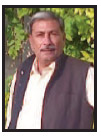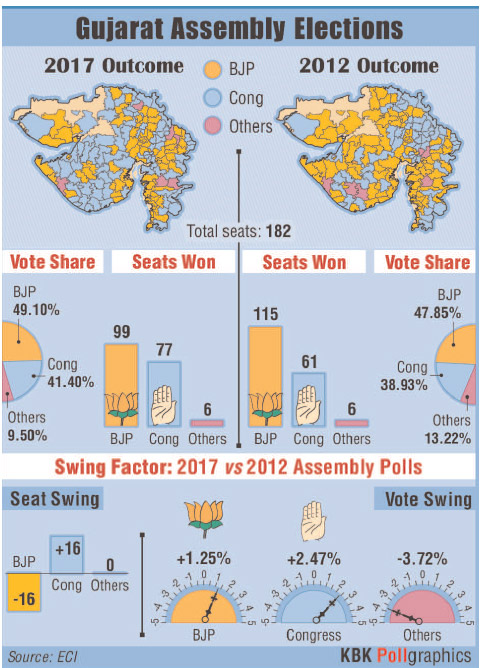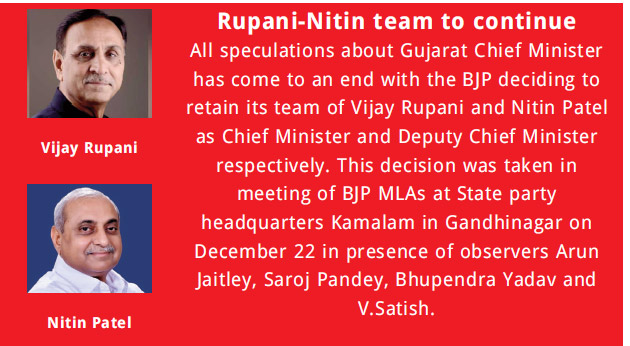Dent in saffron bastion
 Yogesh Sharma
Yogesh Sharma
Verdict 2017 is out.
The ruling
Bharatiya Janata
Party has
managed to retain
power in Gujarat
for the sixth time. But it has to
pay heavy cost for this
achievement. The number of
its MLAs has been reduced to
two digit, just 99, in the worst
ever performance of the party
in last 22 years.
This is despite the fact that the
Gujarat election campaign was led
by Prime Minister Narendra Modi
himself from the front. There were
scores of BJP leaders from outside
Gujarat who held meetings in every
part of the state in their electoral
campaign.
 While Prime Minister
Narendra Modi and senior BJP
leaders are posing a jubilant
mood, it is a fact that the results
will have an impact on the
Assembly elections in 2018 and
the Lok Sabha elections in 2019.
The first causality will be Rajya
Sabha elections when two BJP
MPs are retiring. The increased
strength of 80 in the House of 182
will give the Congress a great
opportunity to defeat the BJP RS
candidate and push at least one
more candidate in Rajya Sabha.
Every election is historic as it is
recorded in history books. But the
Gujarat Assembly election 2017 is
more historic in many more ways. It
has shown waning Modi power in
his home state. No doubt the BJP
has managed this victory only
because of one man army,
Narendra Modi, but the charm of 2014 Lok Sabha elections is missing
when BJP had won all 26 Lok Sabha
elections.
From the election battlefield,
Congress President Rahul Gandhi
has emerged as a strong and
mature political leader with his
style to approach people and
substance to communicate his
political brief. Even in the
Congress defeat, Rahul Gandhi
has come out victorious, not a
laughing stock, as painted by BJP,
but a serious political leader to reckon with. Narendra Modi and
his team will have to deal with
this Rahul Gandhi in 2018 which
will set pace for the 2019 Lok
Sabha election be a decisive
factor for a second term to Modi
in PMO.
While Prime Minister
Narendra Modi and senior BJP
leaders are posing a jubilant
mood, it is a fact that the results
will have an impact on the
Assembly elections in 2018 and
the Lok Sabha elections in 2019.
The first causality will be Rajya
Sabha elections when two BJP
MPs are retiring. The increased
strength of 80 in the House of 182
will give the Congress a great
opportunity to defeat the BJP RS
candidate and push at least one
more candidate in Rajya Sabha.
Every election is historic as it is
recorded in history books. But the
Gujarat Assembly election 2017 is
more historic in many more ways. It
has shown waning Modi power in
his home state. No doubt the BJP
has managed this victory only
because of one man army,
Narendra Modi, but the charm of 2014 Lok Sabha elections is missing
when BJP had won all 26 Lok Sabha
elections.
From the election battlefield,
Congress President Rahul Gandhi
has emerged as a strong and
mature political leader with his
style to approach people and
substance to communicate his
political brief. Even in the
Congress defeat, Rahul Gandhi
has come out victorious, not a
laughing stock, as painted by BJP,
but a serious political leader to reckon with. Narendra Modi and
his team will have to deal with
this Rahul Gandhi in 2018 which
will set pace for the 2019 Lok
Sabha election be a decisive
factor for a second term to Modi
in PMO.
The most puzzling aspect of this
election is the outcome of Surat
where the BJP has retained its hold
with 15 of the 16 seats. Surat,
commercial capital of Gujarat, was
in news all throughout the election
campaign with GST badly affecting textile and diamond industry here.
Individual businessman and trade
and industry organizations were the
quite critical of GST and the
response of the Modi government
to their demand for change in GST.
Though the government brought
changes in GST in 128 items,
demands of Surat traders were not
met. Crowd in the meetings of Rahul
Gandhi and fire brand leader Hardik
Patel had raised lots of hopes for the
Congress. But the results betrayed
the Congress. Had Surat gone the
expected way, the Congress would
have come very close to a majority
of 92.
Not only Surat, all eight Municipal
corporations have supported the
BJP outright. Only Ahmedabad has
shown increase in the number of
seats from two to four. In Junagadh
the Congress candidate has come,
but the overall situation has
remained in favour of the BJP.
 With this
trend the
simplest picture
of the Gujarat
election battle is
of urban -rural
divide. The
Congress had
gained control
of most of
panchayats in
2015 Panchayat
elections. Even
in 2017
elections, the
Congress has
retained its
control over
rural voters. Further interpretation
in terms of Patidar and other
ongoing agitation can be a subject of
academic analysis. The fact is that
there is growing divide in rural votes
in the BJP and the Congress. The
Congress has got 62 seats in rural
areas which is 15 seats more than
what it had in 2012 while the BJP has
got 43 seats with loss of 13 seats. In
urban areas the Congress has got
three more seats.
With this
trend the
simplest picture
of the Gujarat
election battle is
of urban -rural
divide. The
Congress had
gained control
of most of
panchayats in
2015 Panchayat
elections. Even
in 2017
elections, the
Congress has
retained its
control over
rural voters. Further interpretation
in terms of Patidar and other
ongoing agitation can be a subject of
academic analysis. The fact is that
there is growing divide in rural votes
in the BJP and the Congress. The
Congress has got 62 seats in rural
areas which is 15 seats more than
what it had in 2012 while the BJP has
got 43 seats with loss of 13 seats. In
urban areas the Congress has got
three more seats.
The lesson of the election is
that the BJP should focus on the disenchanting rural voters while
the Congress should try to wean
away urban voter from BJP. Another major factor that
played a vital role in the 2017
elections is internal dissension in
the BJP. For the first time in 22
years, there were cases of open
revolt in the BJP with its MPs
threatening to quit the party if
their relatives were not given ticket. Many protested party's
decision not to give ticket to
them.
BJP Won in Ahmedabad 16
seats out of 21. Surat 15 out
of 16. Vadodara 9 out of 10.
Rajkot 6 out of 8. 46 out of 55
in total. If we don't consider
these 4 big cities then out of
127 BJP - 53, Congress - 71,
Other - 03. These 4 cities
made BJP win.
The results reflect this dissension.
Six of BJP Ministers and the speaker
have lost. Seven of the nine
Congress MLAs who had switched
over to BJP in July this year in a revolt
engineered by former CLP leader
Shankarsinh Vaghela were defeated
as there was strong opposition to
these outsiders within the BJP.
Shankarsinh Vaghela had
entered into the election battle field with the cry that Gujarat was ready
for the third party as people were
fed up with both the ruling BJP and
the opposition Congress and
wanted change. However, there was
confusion over his concept of the
third option in Gujarat and he was
regarded as B team of the BJP to cut
vote share of the Congress. He
floated Janvikalp front but borrowed
election symbol of tractor of a
Rajasthan-based least known
political party.
He failed miserably. All his over
100 candidates lost deposits. His
front gained 0.03 per cent of votes
polled and was second from the
bottom.
NOTA played a big role as 1.8
per cent voters opted for the
None of the Above (NOTA) option
affecting results of more than 20
seats.
In terms of votes polled, both the
Congress and the BJP have
r e g i s t e r e d
increase. The
Congress has
gained 2.47 per
cent more votes
as its polling
percentage has
increased from
38.93 per cent in
2012 to 41.40
per cent in 2017
while that of the
BJP has a gain of
1.25 per cent.
But average
d i f f e r e n c e
remains almost
the same, eight
per cent. This has made a difference
of 17 seats for the BJP which had
216 seats in 2012.
The Congress had the battle cry
of Navsarjan. Though results have
not brought the Congress to power,
the defeat of its three top leaders,
Shaktisinh Gohil, Arjun Modhwadia
and Siddhartha Patel has made it
bring new faces in state. Though
these three leaders were defeated
in 2012 also, they were the visible
face of the party in the media and
thus in public.




 Yogesh Sharma
Yogesh Sharma
